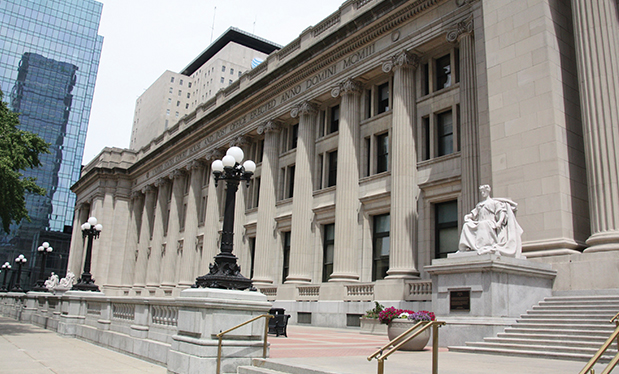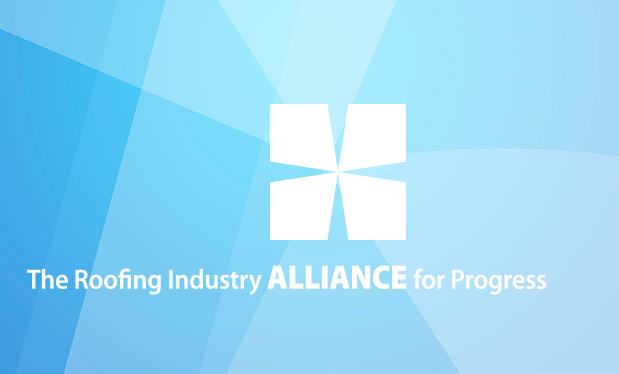Restoring and extending the life of an aging but still structurally sound roof system not only saves money, it also is faster, easier, more environmentally responsible and less disruptive to building occupants than replacing it. So it's no surprise the use of white reflective coatings has dramatically increased during the past decade. Mule-Hide Products Co. Inc., Beloit, Wis., estimates the annual percentage growth in this industry segment to be in the high single digits.
In the past, water-based acrylic coatings and solvent-based urethane and SEBS-type coatings have been the go-to choices. These products have decades of successful use in the field. But increased use has revealed their limitations, such as longer cure times in cold weather. The high-solids 100 percent silicone roof coating systems found in the current marketplace provide another option that can deliver years of energy-efficient, low-maintenance, watertight performance while alleviating many of the drawbacks associated with other technologies.
Water-based and solvent-based
Water-based and solvent-based coatings offer the following advantages:
- They are compatible with a wide variety of roof systems.
- They provide long-lasting performance. Roofs that remain structurally sound can be recoated to extend their lives.
- When "cool roof" colors are used, the coatings deliver excellent solar reflectance and emissivity, helping keep buildings cooler during the summer and helping mitigate the "urban heat island effect," according to the Cool Roof Rating Council (CRRC).
- Acrylic coatings are particularly contractor-friendly, offering a strong cost-performance balance, easy application and quick, simple clean-up.
However, these technologies have the following limitations:
- They are not highly resistant to the greases, fats and oils to which roofs on some commercial and industrial facilities are exposed.
- When regularly exposed to ponding water, they do not perform as well long-term as silicone coatings. Freeze/thaw cycles accelerate the breakdown of water-based coatings as water is absorbed by the coating and freezes. Solvent-based coatings perform better than water-based coatings but generally are impermeable; any moisture in the substrate will be trapped beneath the coating, causing the coating to bubble and blister as the moisture vaporizes.
- Weather forecasts and climate conditions must be carefully considered when using water-based coatings. The coatings cure more slowly in cool or humid weather and during times of the year when the sun is lower in the sky. A sudden rain or heavy dew can wash away uncured coatings. The coatings should not be applied if temperatures will dip much below freezing during or within hours of application. And mold and fungi can be an issue in warm, humid climates as they feed off the coating's organic compounds.
- Solvents are expensive, and they evaporate. As much as 55 percent of the volume of solvent-based coatings is solvents. Much of this content evaporates during the application and curing processes.
- Regulations related to the emission of volatile organic compounds (VOCs) are becoming more stringent. Solvent-based coatings that have been reformulated to comply are more expensive than their predecessors and have lost some performance attributes. Depending on the solvent used, this can include some or all of the following: increased odor; greater flammability; dry times that are either extended or too fast; poor cold-weather application; increased overspray; and incompatibility with pump and equipment seals.
- Solvents can emit noxious odors, so precautions must be taken when using solvent-based coatings to prevent vapors from entering facilities.
High solids
To address the limits of water-based and solvent-based coatings, manufacturers developed high-solids coatings that do not contain water or solvents. Instead, the resin itself is the carrier, and the coating cures by chemical reaction.
High-solids 100 percent silicone coatings are among the most recent of these technologies. They are based on the silicone polymer silanol terminated polydimesthylsiloxane—or OH polymer—with hydroxide (OH) groups present. They are oxime-neutral (condensation) cure, absorbing atmospheric moisture to cause the reaction that turns the coating into a protective film. These coatings typically contain solids in excess of 95 percent.
The solids content is a crucial distinction. Low-solids silicone coatings have been used on roof systems for more than 40 years, but they typically contain 30 to 40 percent solvents to reduce their viscosity. As such, they have the same limitations as solvent-based systems.
The pros
The OH polymer backbone they are based on and the lack of solvents or water content give high-solids 100 percent silicone coatings significant strengths, making them good choices for use in some challenging situations. They offer excellent adhesion to a wide array of substrates, including asphalt, polymer-modified bitumen, metal, concrete, TPO, PVC and EPDM. High-solids 100 percent silicone coatings are known for their excellent ability to seal off water entry points.
Wet and dry film thicknesses virtually are the same. The product applied to a roof stays on the roof rather than evaporating into the atmosphere. Therefore, less product must be hauled up to the roof and applied to achieve a desired film thickness.
Being solvent-free, high-solids 100 percent silicone coatings comply with VOC-related regulations. Although they release some ingredients as a byproduct of the curing process, they are low-odor, allowing them to be used on hospitals, schools, residential buildings and other facilities with occupants who may be particularly sensitive to solvent fumes.
High-solids 100 percent silicone coatings cure quickly with same-day recoating possible. This makes them a good choice when working in cool or humid weather, early and late in a season, and in areas where sudden rains are common.
Because high-solids silicone coatings absorb minimal water, they outperform other technologies in areas that retain water. However, they are not a cure-all. Ponding water causes, or is related to, defects in a roof or its structure that cannot be solved by a coating product alone. Coatings are not a substitute for proper roof system design and drainage, and they are not a fountain of youth for roof substrates that are beyond the end of their life cycles.
The OH polymer in high-solids 100 percent silicone coatings is naturally light-stable, making the coatings highly resistant to ultraviolet radiation.
High-solids 100 percent silicone coatings resist chemicals, allowing them to be used in such applications as industrial buildings, food-processing facilities and airports where environmental conditions could cause other coatings to fail prematurely.
High-solids 100 percent silicone coatings are vapor-permeable. Moisture trapped in the roof substrate can escape as it vaporizes, preventing the coating from bubbling and blistering. And because they contain no organic compounds, high-solids 100 percent silicone coatings resist mold and fungi growth.
The cons
As with any technology, high-solids 100 percent silicone coatings have limitations.
Silicone coatings are more challenging to apply than water- and solvent-based coatings. Roofing contractors should work with the coatings manufacturer to ensure their crews are properly trained for applying the specific brand of coating. In particular, they should become proficient in calculating cure times and adjusting to such conditions as wind, humidity and temperature.
When a crew is applying a coating for the first time, taking advantage of job starts is extremely valuable. A job start is when a manufacturer's representative is available on-site to answer questions, offer application suggestions, and point out potential errors to avoid or correct.
Unlike water-based coatings, cleanup of tools and equipment requires using a specially formulated cleaner instead of water that comes with a silicone roof coating system.
Water-based and solvent-based coatings will not stick to silicone, so when the time comes to recoat a roof, silicone coatings must again be used.
Silicone coatings tend to pick up more dirt than other roof coating technologies. This causes a greater decrease in their solar reflectivity over time, as demonstrated in CRRC's Rating Program through which roofing product manufacturers can submit products to be tested for their radiative properties. High-solids 100 percent silicone coatings with good three-year aging results are available.
Application
Following are some tips to help ensure proper application of high-solids 100 percent silicone roof coatings.
A professional silicone roof coating system typically contains the following products:
- A cleaner to prepare the substrate for priming
- Primer to improve adhesion of the top coat to the substrate
- A multipurpose sealant for use when completing repair and maintenance tasks
- Top coats for use on substrates, masonry walls and skylights
- Cleaning solvent to wash tools and equipment
Silicone coatings can be applied with a brush, roller or sprayer. Special high-pressure rigs have been developed specifically for use when applying silicone roof coatings.
Primers are required for most coating applications—especially when working in areas that retain water. Although silicone roof coatings outperform other technologies in ponding water applications, adhesion to many substrates will be reduced to the point of failure without a properly designed and applied primer. Beware of products that claim a primer is not needed; primerless applications consistently have failed in ponding water areas.
Two top coats applied in opposite directions will provide the best results. Thin spots, pin holes and other imperfections are virtually guaranteed in one-pass applications. Even products claiming to require only one coat invariably come with the caveat that additional coats may be required.
Silicone roof coatings must be mixed before application. However, care must be taken to not create air bubbles. Air bubbles contain moisture, which may start the curing process.
When brushes and rollers temporarily are not in use, such as during crew breaks, they must be kept in the silicone coatings to keep the product on them from curing.
Once a container has been opened, silicone coatings should be used immediately or they will begin to cure. If a "skin" develops on top of the coating, it can be removed and the remaining product can be used. Periodic stirring during application will help prevent skins. To limit skins and aid in their removal, plastic film can be pressed onto the unused coating in a container.
Shelf lives of silicone roof coatings range from six months to two years. Roofing contractors should rotate their stock and use materials promptly to prevent changes in viscosity and cure rate.
Warranties
Various types of warranties are available with high-solids 100 percent silicone roof coating systems. Most require a designated number of coats be applied and specify coverage rates per coat.
Material warranties only cover the replacement of defective materials. Reapplication costs are not covered. Many manufacturers offer a nontransferable material warranty for terms of 50 years or a roof system's lifetime. It should be noted these warranties only cover defects in the manufacture of the coatings product on the day it was made. They also do not cover the existing roof or guarantee the existing roof is capable of lasting as long as the coating that is applied to it.
System warranties guarantee the material and the installation are free of defects.
Years of performance
As building owners continue to seek out ways to maximize the life cycles of their roof systems and forestall the costs, waste and disruptions associated with roof system replacements, the use of roof coatings will continue to grow. High-solids 100 percent silicone roof coatings provide an alternative to conventional water-based acrylic and solvent-based technologies, overcoming many of the limitations of these products and delivering years of energy-efficient, low-maintenance, watertight performance to building owners.
Kate Baumann is director of marketing and procurement for Mule-Hide Products Co. Inc., Beloit, Wis.



